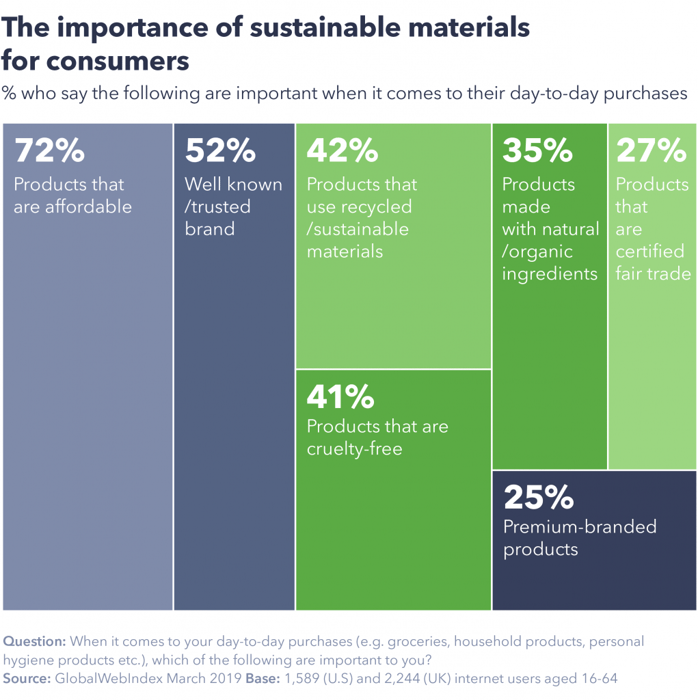
Anastasia Masters is a Content Marketing Associate at G2. Follow her at @anastasia_mm0.

Anastasia Masters is a Content Marketing Associate at G2. Follow her at @anastasia_mm0.
The world of consumer packaged goods (CPG) is transforming. To stay relevant in the industry and work to beat out your product's competition, you’ll need to keep on top of CPG industry trends for the future. Get ahead of the game and dive into what’s next for 2021.
Although some CPG brands seem to top their industry with no competitor in sight, it’s clear in the digital age (even in food and packaging products!) that a disruptor can come in and shake things up almost overnight – whether in your organization's talent, business, or product. So what makes a brand stand apart from the rest?
In a society where we are constantly overloaded with information (aka “content shock”), consumers use this explosion to hold brands to corporate social responsibility better. Beyond that, expect in 2021 that transparency will continue to be top of mind for your loyal customers and the products they buy.
The power of product co-creation with customers is strong, which is why Heinekin asked its customers to come up with new, sustainable bottle concepts. The beverage company added an extra element of fun by holding a contest for the most innovative customer idea.
The contest was an excellent way to engage customers, as well as publicize Heineken’s packaging process and materials.
Transparency can come in many different forms. You can choose to be transparent where your products are sourced - whether locally in the United States, at a specific point in the supply chain, or even in emerging markets. You can even publicize this by adding your eco-friendly product to the Clean Label list.

Transparency can also mean giving your CPG brand an authentic voice and targeting consumers in a way that is true to your product and organization. Identify your brand messaging and the information you are delivering to your customers. See where you can continue to be transparent and identify areas where improvement is needed.
In 2021, if your organization isn’t making strides to being more sustainable, you’re behind in the overall CPG industry. With a heavy concern from consumers on the state of our earth, it’s important that we are building brands that are safer in their production methods and participate in green marketing initiatives.
Nestlé has committed to making 100% of its packaging reusable and recyclable by 2025, which could leave less agile food and beverage companies in the dust. It’s also committed to reducing its carbon footprint to net-zero by 2050.
Sustainability is important for both the production and packaging of your product. Suppose your brand isn’t practicing sustainable product development, research where you can improve in this area. Can you save plastic and shelf space by paring down your packaging or use organic wrappers for more durable goods?

If you practice sustainable production or use sustainable packaging, make sure that it's clear on your website with a brand positioning statement. Although it’s not recommended that you use it as your leading marketing tactic, it’s an extra point that can convince customers to choose your product over an industry competitor.
A trending area to keep your eye on for 2021 is how the field will expand to the services industry. The expansion in the industry allows for brands to connect with consumers outside of their traditional product offerings.
Tide offers an actual laundry and dry cleaning service in select cities, a natural transition from their original product offering of laundry detergent. This is an opportunity to not only drive customers to a retail location (for drop off,) but also introduce consumers to a new cleaning product they may not use since Tide laundry facilities exclusively offer Tide products.
This trend isn’t going to work for every brand.
A lot of factors depend on your organization being able to expand into areas of customer delight. Your product needs to have a service that isn’t too far of a stretch from your product, and your organization needs to have the capital means to offer it.
This trend isn’t going to disappear anytime soon, especially with the advent of “experiences” in the industry, and it’s an area to consider investing in to connect with your customer base further.
In 2021 and beyond, a CPG product's digital presence is no longer optional, it’s necessary. As more and more companies begin to market their business online through various digital marketing techniques, online marketing has become a critical tool in connecting with new audiences and influencing purchase decisions.
Consumers are connecting with brands outside of their local Stop & Shop and brick-and-mortar stores. If you scroll through Twitter or Instagram, feeds are filled with consumer brands jumping in on internet trends or posting photos that showcase their product outside of typical advertising.

This digital presence may seem like a marketing decision for your brand, but consumers see it as a way to connect with your brand message.
Brands are developing their own voice, so it’s important to identify your voice for your CPG brand. By cultivating a well-developed brand voice, it’ll help your company stand out from the masses by establishing a framework to work around when creating content. In turn, your now branded content will be recognizable and memorable, allowing consumers to recognize your brand when scrolling through their feeds automatically. Once you’ve established your brand voice, remember to maintain and further develop it on all of your social media platforms.
With the help of the team and big data from Google Analytics, Starbucks identified multiple trends in the United States that could be used to create a limited-time drink offer. The coffee giant settled on “unicorn” as a trend before other industry competitors were able to, and developed the Unicorn Frappuccino.
In addition to an explosion of Unicorn Frappuccino photos on Instagram, Starbucks saw a 4% increase in profit that month, which analysts attribute to the limited-time drink.
Use your captions and different images to help cultivate the persona around your brand. Creating an online persona should be especially easy since marketing in this particular industry already relies on the senses. Identify the tone and image you want to portray and make sure that all communication coming from your brand reflects these choices.
The digital world isn’t going away any time soon, so it’s crucial to have a digital presence for your product brand, including social media and dedicated web pages. Make use of social and digital to connect with your customers outside of the use of your product to strengthen the relationship.
Consumers love a subscription service. It simplifies the purchasing process and allows for a needed product to be delivered straight to their doorstep without the extra step of ordering it.
Subscription-only businesses like Stitch Fix and Dollar Shave Club (even before purchase by Unilever) have a significant presence in the marketplace, with the latter encroaching on market share for more traditional personal care brands like Gillette. This is perhaps because many personal care purchases are discrete or tedious. A delivery (inside a colorful box with a personal note) makes the product exciting for the first time. 
Even established brands such as Chewy and Amazon, not necessarily known for their recurring orders, offer subscriptions for products that you’ll need to order again, like cleaning products or toiletries. Don’t expect this trend to disappear in 2021.
Consider offering a recurring subscription option on your product checkout page or unique point of sale. You can even give a slight discount for subscription sign-ups to encourage repeat orders. Having this option prevalent on your site can encourage subscriptions from life-long customers to potential customers viewing your site for the first time.
Additionally, subscription model businesses have an incredible opportunity to use predictive machine learning to suss out consumer demands and renewal habits.
Consumers don’t want an extra step, so by offering a subscription right off the bat, you’ll encourage higher sales and create a consistent relationship with your customers. You can be their go-to product without them having to choose you every time.
As a result of COVID-19, a historic shift in consumer behavior has occurred. Organizations that value agility and adopt agile principles are more likely to sustain this massive change – primarily, the move from out of the home to in-home experiences.
When Unilever detected change in the market, the organization responded with a people-first mentality. Instead of laying off employees en masse, the CPG company redeployed teams where demand had increased – especially toward supply vendors and distribution.
Establish clear priorities ahead of time and in anticipation of change. One of the best ways to measure a pulse on the state of internal affairs is to ask employees. Your organization can do so at scale and iteratively by adopting technology like online focus groups to measure employee feedback. Other digital transformation opportunities are also available, and it can be opportune for some organizations even to hire a transformation coach to facilitate change.
As brands spread their name due to the interconnectedness of the internet, your company is likely to reach a new group of consumers who weren’t reachable a decade ago. If your brand can distribute on a larger scale (whether state-wide, nationwide or even internationally), it’s important to cultivate a consumer relationship outside your local target audience.
Instead of having one targeted group of consumers, it’s important to use multiple personas representing a wide variety of market segmentation that your audience may encompass. Additionally, you can even target different groups to gain feedback and identify how they use your product.
It’s crucial to view your customers outside of their use of your product, and even outside of the business at large. Find out who they are and what they value using tools like FullStory or Crystal. You can then use this information to create a personalized experience for your buyers.
The more personalized the customer's experience is, the more likely you are to have a higher rate of satisfaction. This can lead to a customer base that is loyal to your brand.
Consumers often purchase goods with a proactive focus rather than a reactive one. This change has lead to an increase in products that satisfy a want rather than a need, and in the CPG field, leaning into this trend seems like a no-brainer.
Without a doubt, cultivating a brand image and a positive customer experience can help facilitate brand loyalty. This can also encourage consumers to choose your brand even when they may not need your product.
In an industry so fast-changing the term is in the name (i.e., FMCG), it may seem frustrating to move the focus from one trend to the next. However, if you don’t have this forward-thinking mindset, your product will likely be left in the dust of your industry competitors.
Consumers are more connected to brands and products than ever before, so it’s crucial that your company fosters the relationship and tries to connect with your customers outside of your basic product offering. Focusing on transparency and sustainability will help develop your business with long-term strategies that will delight consumers and increase your organization's integrity.
Keep your vision in 2021 and be prepared for the next big thing that may disrupt CPG companies and the industry at large.
Want to know what 100+ shoppers think about eCommerce and shopping experiences? Check out our latest report!
© 2024 | All rights reserved